The 2013 MacBook Air Review (11-inch)
by Vivek Gowri on August 9, 2013 1:45 AM ESTThe performance story is a bit interesting. There are two sets of 15W Haswell ULT parts, some with HD 4400 (GT2) and others with HD 5000 (GT3) onboard graphics. The GT3 parts, in order to hit the same TDP, run lower clock speeds. Apple chose to go for GT3 across the board. This isn’t the first time that Apple has made the decision to sacrifice CPU performance for the sake of GPU, but this was probably a pretty easy choice for them compared to 2010, when they skipped Arrandale on the 13” MacBook Pro and Airs for Penryn-era Core 2 Duo and Nvidia’s G 320M. That particular IGP was pretty fast, so much so that the substantially improved HD 3000 that came with the Sandy Bridge mobile parts was actually a bit of a downgrade on them.
The CPU tradeoff here is substantially less than it has been in the past, so this is a bit of a no-brainer. The i5-4250U in the base 2013 MacBook Air is clocked at a low 1.3GHz but has the same 2.6/2.3GHz (single core/dual core) turbo clocks as the 1.6GHz i5-4200U with GT2 graphics. The clock speed difference is even less at the high end: the optional i7-4650U is clocked at 1.7GHz and turbos to 3.3/2.9GHz while the fastest GT2 ULT part, the i7-4500U, runs 1.8/3.0/2.7GHz. The hit you take on base clock is pretty easy to justify for the more powerful GPU.
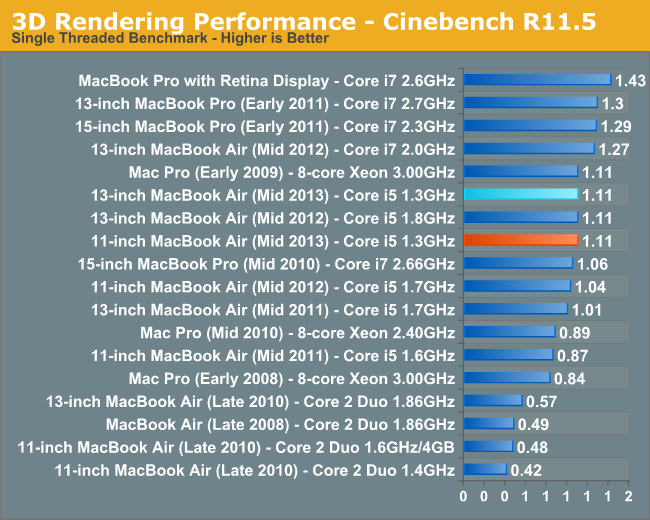
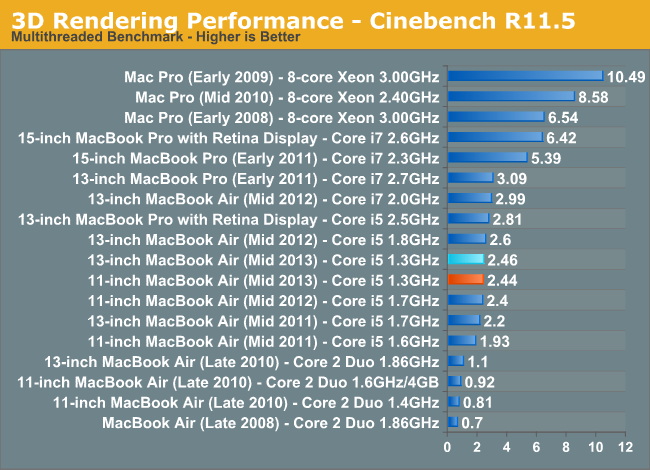 With that said, the raw performance isn’t really that great. The 13” Air that Anand reviewed was slower than its immediate predecessor, which used a 1.8GHz i5-3427U. The base 11” last year used an i5-3317U (1.7GHz) and that’s actually not a whole lot faster than the 11” Air I have here. The results are basically all within margin of error for the tests, so I’m content to call it basically even with last year’s model. The Air isn’t slow, but it can certainly get pokey at times. This is no different than any Ultrabook-class machine, but worth noting. Turbo and the very fast SSD keep things going smoothly in normal day-to-day tasks, but anything substantially more intensive than a browser and iTunes is going to be outside the comfort zone of a system like this.
With that said, the raw performance isn’t really that great. The 13” Air that Anand reviewed was slower than its immediate predecessor, which used a 1.8GHz i5-3427U. The base 11” last year used an i5-3317U (1.7GHz) and that’s actually not a whole lot faster than the 11” Air I have here. The results are basically all within margin of error for the tests, so I’m content to call it basically even with last year’s model. The Air isn’t slow, but it can certainly get pokey at times. This is no different than any Ultrabook-class machine, but worth noting. Turbo and the very fast SSD keep things going smoothly in normal day-to-day tasks, but anything substantially more intensive than a browser and iTunes is going to be outside the comfort zone of a system like this.
Considering the power efficiency though, getting similar performance to the old model even with 30% slower base clocks is a decent bargain, particularly when accounting for the increase in GPU and storage performance. I’m not going to go too far into those, since Anand did a really deep dive in his 13” Air review. It’s worth noting that while his Air had a Samsung SSD, the supplier lottery churned out a SanDisk SSD in my unit. The switch to PCIe SSDs really does make itself felt in day to day use, particularly in sleep/wake situations, as well as when launching particularly large applications (that then crawl their way through the power-sipping i5 ULT). I honestly didn’t expect that, given how accustomed I’ve become to the responsiveness of fast SSDs in general, but it’s pretty important to the MacBook Air simply in terms of keeping the system feeling quick to the touch.
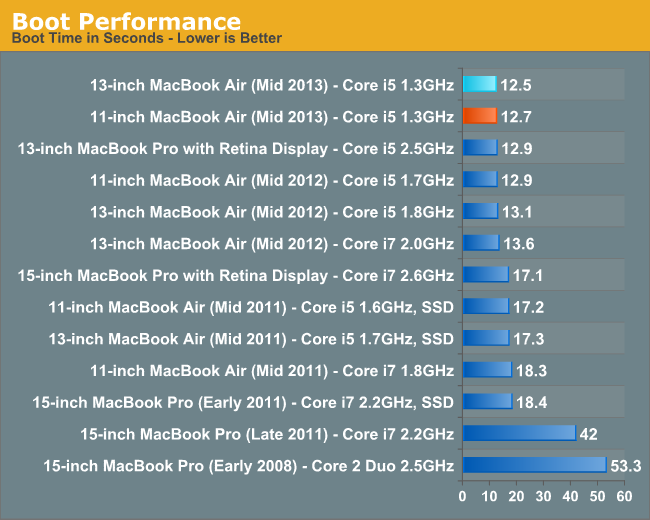

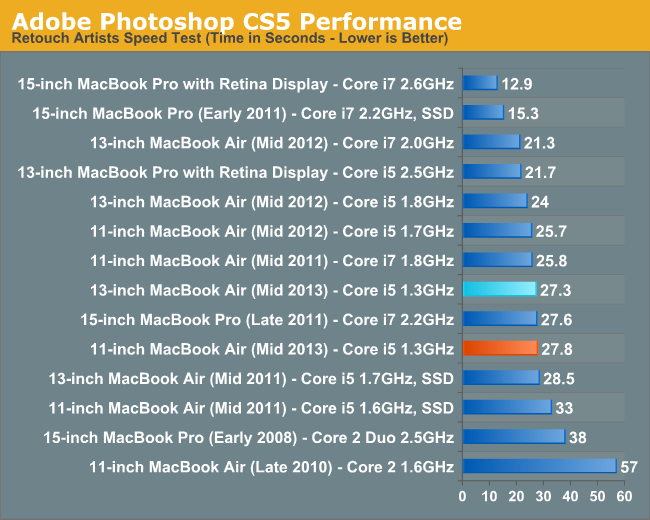


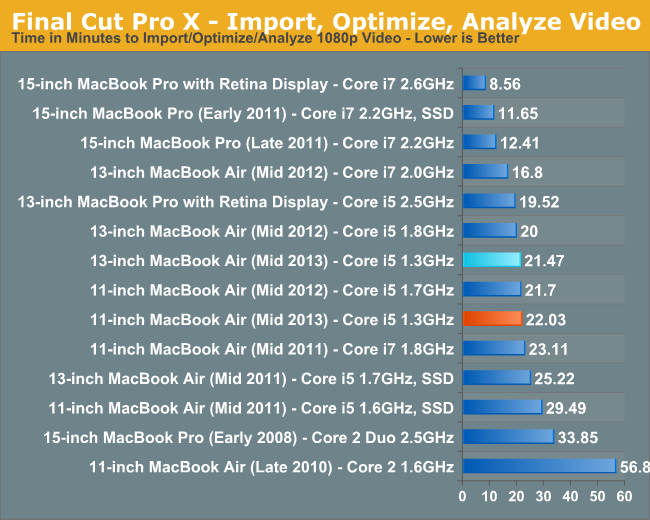










139 Comments
View All Comments
repoman27 - Friday, August 9, 2013 - link
For some reason Apple is still using Cactus Ridge DSL3510L 4C controllers in the 2013 Airs.Technically the configuration could drive any 4K display on the market just fine, even with only a single port exposed. The problem is the lack of daisy-chainable Thunderbolt devices with dedicated DisplayPort / HDMI 1.4 / dual-link DVI ports.
Theoretically, you could build a device in the $80 retail range with two Thunderbolt controllers and two DP ports just to drive 4K displays.
Darkfire - Friday, August 9, 2013 - link
I'm impressed with the listed 7 hours of battery life on the Macbook Pro (Early 2011). I have gfxCardStatus and keep it forced on integrated most of the time, and usually get around 5 and a half.darwinosx - Friday, August 9, 2013 - link
Why does Vivek do Apple anything reviews? He makes many mistakes while progressing to prefer Windows. Leave the Mac reviews to Anand who knows what he is talking about and does not have an anti-Apple bias.Also how is their no performance improvement when the sad is twice as fast and destroys anything else on the market? You know the SSD's that you didn't event set or show stats for? Ridiculous.
KPOM - Friday, August 9, 2013 - link
Since the 11" and 13" MacBook Air models have the same processors this year, (both in base and upgrade form), apart from the impact of thermals the performance should be pretty similar. I think a separate review from someone else is warranted. As for pro- or anti-Apple bias, let's face it. While Apple legitimized and mainstreamed the ultraportable category (which was largely restricted until 2010 to an ultra-expensive and underpowered niche), most people use Windows. It's good to get some different perspectives.ananduser - Saturday, August 10, 2013 - link
"Mainstreamed" is a stretch; only by virtue of their limited lineup and by positioning ultrabook skus at the low end. I'm saying average macusers aren't rushing for the form factor but for the entry level price. In the Windows world ultrabooks are still a niche because more inexpensive alternatives exist.KPOM - Saturday, August 10, 2013 - link
Regardless of why, the bottom line is that before October 2010, ultraportables (including the earlier MacBook Air) were not very popular and were mostly executive toys. After October 2010, they became popular and as sales of the MacBook Air improved, more manufacturers started making them.The 13" MacBook Pro has outsold the MacBook Air, so I doubt that it was solely price that drove MacBook Air sales. I think people genuinely like the smaller form factor. I've long preferred ultraportables and was an early MacBook Air buyer (February 2008). The only reason I switched was for the Retina Display on the 13" rMBP.
solipsism - Friday, August 9, 2013 - link
1) Maybe they think they are being more "objective" by having someone make such subjective, anti-Apple comments in some of their Apple-released reviews.2) Anand already tackled the new SSD last month, as well as the new 13" MBA.
• http://www.anandtech.com/show/7058/2013-macbook-ai...
• http://www.anandtech.com/show/7085/the-2013-macboo...
VivekGowri - Saturday, August 10, 2013 - link
I'm somehow characterized as an Apple fanboy by the other notebook editors on staff, but I'm glad that you can look past that and make sure someone who's literally owned every Apple product released over the last five years other than the Mac Pro can be called out for hating Macs. That takes a lot of analytical depth and strength of reason.Refresh my memory though, where do I say anything particularly anti-Apple? Or that I prefer Windows? I ask only because OS X has been my primary mobile OS for the better part of the last three years, and if you have insight into my tastes that perhaps I am not aware of, I should heed your advice and move off the platform.
VivekGowri - Saturday, August 10, 2013 - link
Also, Haswell IPC stayed flat relative to IVB. Lowering clock speed naturally means that CPU performance goes down. Deal with it. I mentioned that the SSD helps balance the performance gap in daily usage, but damn if you can use it to claim a typical generational bump in raw compute power. That's not the point of Haswell, but it's still important to recognize the strengths and faults of the platform. Did you actually read the review?nerd1 - Saturday, August 10, 2013 - link
There are lots of mSATA RAID 0 setups among new windowsbooks, and they are a) just as fast b) user expandable c) WAY cheaper than proprietary solution.And I highly doubt MBA can do any serious task that can benefit from faster SSD.